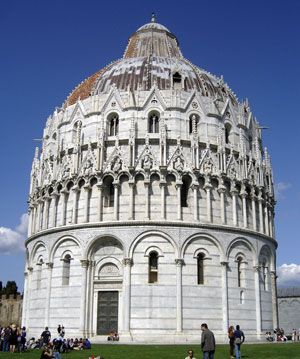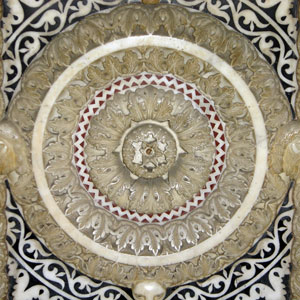

The Baptistery of Pisa, called as a "Jewel box"

The baptismal font located in the center of the baptistry was constructed by
Guido da Como in the middle of the 13th century. The each side is decorated with
beautiful roses and inlaid marbles.

Pulpit by Nicola Pisano.
The construction started in 1152 by architecture Diotisalvi, and involving the Pisano family, completed in 1363 under the direction of Cellino di Nese.
The baptistery is an example of the transition from the Romanesque style to the Gothic style. the lower registers are in the Romanesque style, with rounded arches, while the upper registers are in the Gothic style, with pointed arches Pinnacles amd pediments (triangular gable walls). Since it looks like a delicate lace, "jewel box" is the best nickname to this beautiful baptistery.
For the vault which consists eight terms it's used partly marble veneers, and unglazed tiles (brown parts). At the entrance a reproduction of "Madonna and Child" by Giovanni Pisano is located (the original work is conserved in the Dumo Art Museum).
The pulpit was sculpted between 1255-1260 by Nicola Pisano, father of Giovanni,
the artist who produced the pulpit in the Duomo.
On the columns there are statues
of personificated virtue, and on the arch it can be seen Prophets. Five pannels
represent the life of Christ, "Annunciation
and the birth of Christ", "Adoration of the Kings", "Consecration
of Christ", "Crucifixion" and "Last Judgement".
"Campo Santo" can be literally translated as "holy field".
The construction of this huge, oblong Gothic cloister was begun in 1278 by the
architectGiovanni di Simone and finished in the 15th century.
At the entrance
on the right side there are four statues of kneeling donors and saints surrounding
the Madonna and Child. This Gothic decoration was created by Nino Pisano School
in 1350.
Inside you can see a beautiful rectangular courtyard sorrounded by gothic
corridors. It's said that here a lot of soil of Golgotha hill had been carried
far away from Palestine during the Crusades.
There are displayed the facade of the Duomo and some original statues of the
baptistery.
On the first floor some sculptures of 11th - 16th century are desplayed
mainly, and on the second floor paintings and wooden statues from the 15th to
18th century are exhibited. You can take beautiful pictures of the Leaning Tower
from the corridor on the first floor.
Shinopie means the dessins painted on the mural. Since the brown soil produced in the town of Sinope near to the Black Sea was used to draw outline sketches to mural, it became called like this. The camposanto was lost by the Allied bombardment from the opposite bank of the Arno River in 1944, the Shinopies for frescos emerged from beneath. This museum has a rich collection of drawings of painters from the 13th - 15th century.
It takes 25 min. from the central station to the Square of Miracles if you arrive by train. However, it takes only 5 min. from Pisa San Rossore station by walk. Pisa San Rossore is the nearest station in fact.
So you can access to the Duomo through Pisa San Rossore station first of all, and then visit the townstreets of Pisa, and at the end of your visit you can take a train at the central station of Pisa. I recommend you this route for your smooth visit.